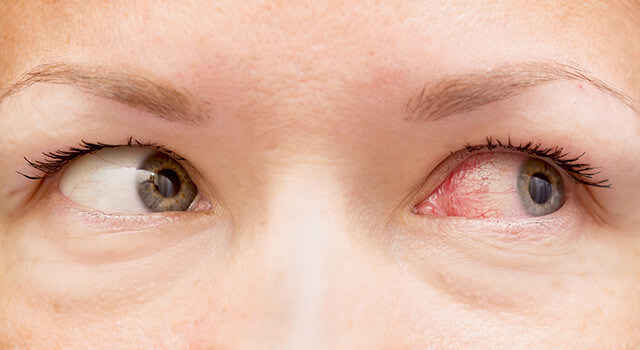You wake up in the morning ready to start your day, only to discover that your eyes are bloodshot. That might not be surprising if you stayed up late to finish a project, had too many drinks at a party or spent time in a smoke-filled room.
But bloodshot eyes can also signal an underlying eye problem. If your eyes appear red or bloodshot, make an appointment with an eye doctor for a comprehensive eye exam to determine the cause and to receive effective treatment.
Why Do I Have Bloodshot Eyes?
When blood rushes to the front of the eye, the tiny red blood vessels on the white of the eye dilate and become visible. This makes the eyes appear red and irritated.
So why do these blood vessels dilate, causing your eyes to look bloodshot?
Bloodshot eyes tend to be caused by:
- Dry eyes
- Irritants such as smoke, pollen and perfume
- Lack of sleep
- Excessive alcohol consumption
- Spending too much time in front of the computer
Bloodshot eyes due to lifestyle and environmental irritants may disappear on their own, or you can try to relieve them with over-the-counter eye drops or liquid tears. Lifestyle changes, such as getting more sleep, cutting down on alcohol intake and limiting screen time can often be helpful. If allergies are the culprit, oral antihistamines and antihistamine eye drops may relieve symptoms.
At other times, underlying problems requiring prompt medical attention can cause your eye’s blood vessels to dilate. The following are some of these medical conditions:
Conjunctivitis
You’ve probably heard of “pink eye.” It's another name for infectious conjunctivitis – an infection of the conjunctiva, the thin membrane covering the eyelid and the front surface of the eye.
There are two types of infectious conjunctivitis – bacterial and viral.
If your child has conjunctivitis, they’re not alone. About 12% of kids get bacterial conjunctivitis every year. This highly contagious condition affects children and adults. In addition to reddish eyes, the following symptoms are associated with conjunctivitis:
- Bacterial conjunctivitis - irritated eyes, swollen eyelids, eye discharge, crusty eyelids and excessive tearing
- Viral conjunctivitis - cold or flu-like symptoms, runny nose, fever, itchy eyes, excessive tearing
If you or your child are experiencing these symptoms, it’s important to schedule a prompt appointment with an eye doctor, who can diagnose whether the conjunctivitis is viral, bacterial or due to allergies.
Depending on the diagnosis, your eye doctor will prescribe antibiotic eye drops or creams to treat bacterial conjunctivitis. The viral form may run its course after a few days, but cold compresses and non-prescription eye drops may provide relief.
Dry Eye Syndrome
If your eyes are chronically bloodshot you may have dry eye syndrome (DES). Signs of DES include:
- Dry, irritated eyes
- Burning or stinging eyes
- Discharge from the eyes
- Light sensitivity
- A feeling you have something stuck in your eyes
- Blurred vision
- Watery eyes
Dry eye syndrome is most commonly caused by a blockage of the tiny meibomian glands in the eyelids. These glands secrete oil that keeps eye moisture from evaporating too quickly. Without the oil, tears dry fast, leaving your eyes feeling dry, itchy and with a bloodshot appearance.
Too much screen time, aging, certain medications such as antihistamines, and medical conditions such as Sjogren’s syndrome can cause dry eye syndrome.
In addition to any medications or in-office treatments your eye doctor recommends, make sure to get plenty of hydration, take frequent breaks from digital screens and use a humidifier in your home.
Uveitis
In addition to bloodshot eyes, if you also experience blurred vision, see floaters or your eyes feel painful, you may have an eye inflammation called uveitis. The causes of uveitis include:
- Autoimmune or inflammatory condition
- Infection
- Medication side effects
- Cancer (in rare cases)
Unfortunately, uveitis symptoms can often be mistaken for something less serious. That’s the reason it’s important to get an eye exam if your eyes are bloodshot. Left untreated, uveitis can lead to serious conditions such as retinal scarring, cataracts and vision loss.
Depending on the cause and severity, your eye doctor may treat uveitis with prescription eye drops, steroid pills, injections or eye implants.
Eye Injury
It’s vital that all eye injuries receive immediate eye care from an eye doctor.
Even a minor eye injury can cause a big red blotch to form on the white part of the eye (sclera). The cause is a broken blood vessel or a subconjunctival hemorrhage.
Although the appearance of this blood looks severe, and can make the entire white part of the eye appear bright red, a subconjunctival hemorrhage is usually painless and doesn’t cause vision loss. Any time you notice excessive blood on the eye following an eye injury, schedule an appointment with an eye doctor to assess the health of your eye.
Glaucoma
In rare cases, bloodshot eyes may signal the presence of glaucoma – a leading cause of vision loss and blindness.
While some types of glaucoma don't show symptoms in the early phases, bloodshot eyes can indicate the type of glaucoma that requires immediate medical care. This disease causes damage to the optic nerve due to excessive pressure within the eye. When this pressure suddenly rises, the eye’s blood vessels become dilated and visible, making the eye appear red.
If you have bloodshot eyes and/or have the following risk factors for glaucoma, immediately schedule an appointment with your eye doctor.
- Family history of glaucoma
- Aged 60+
- African American, Asian or Hispanic
- Diabetes
- High blood pressure
Bloodshot Eyes Won’t Go Away?
Talk to Us Any time you notice bloodshot eyes or blood on the front of the eye, don’t wait. Schedule your eye exam with Dr. Heather Alcorn at Ohio Low Vision Center in Stow today.
Q&A With Your Local Optometrist
Can I get bloodshot eyes after LASIK surgery?
LASIK surgery is highly effective minimally invasive laser eye surgery that can correct refractive errors, but like all surgical procedures, it can have side effects. Your eyes may be bloodshot or you could see halos from a few days to three weeks after surgery. Additionally, you may experience other dry eye symptoms. Eye drops and liquid tears can alleviate these symptoms, but if you have any concerns about your eyes following LASIK surgery contact your eye surgeon.
What Should I Expect from a Glaucoma Exam?
If you have a family history and/or other risk factors for glaucoma, and if your eyes look bloodshot, consider scheduling a glaucoma exam. Your eye doctor may perform the following tests:
- Tonometry - eye pressure test
- Gonioscopy – to see how fluid is draining out of your eye
- Vision field test – to examine the functioning of the optic nerve
- Dilated pupil exam – to detect any damage to the optic nerve
- Retinal photo or OCT - digital examination of the retina and optic nerve health


